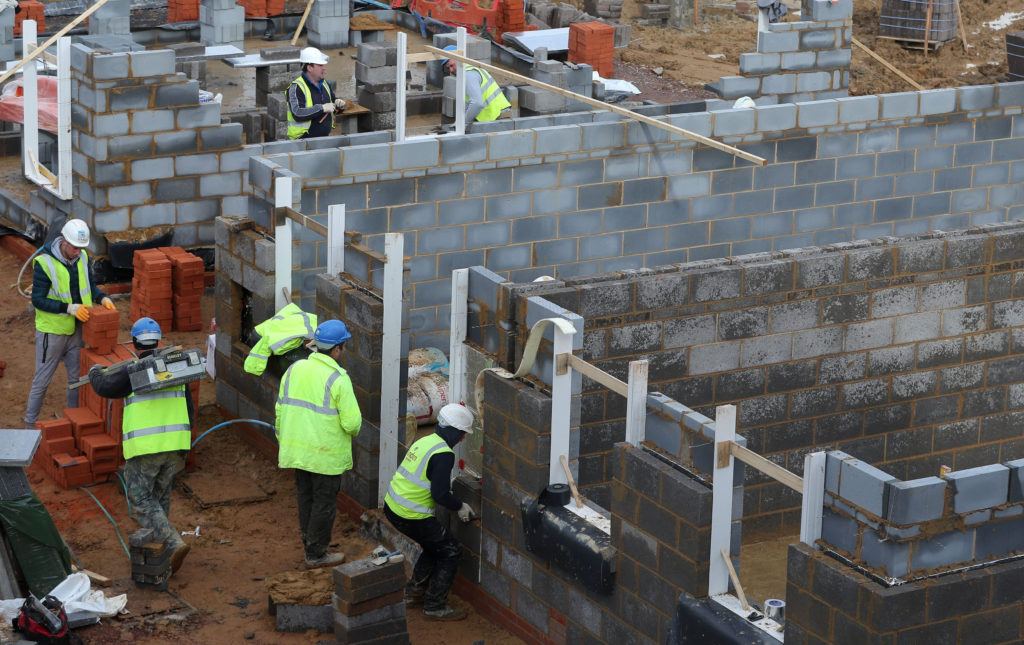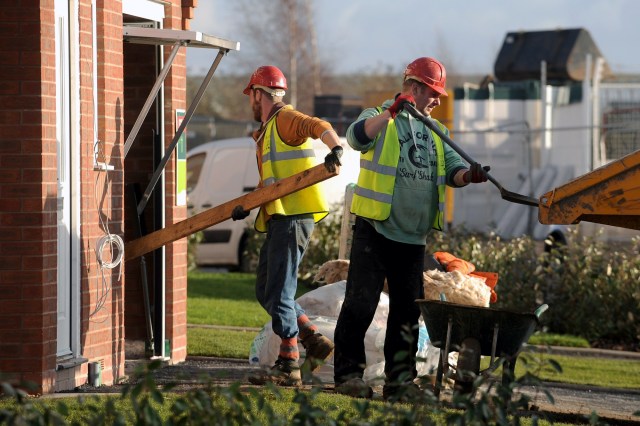Credit: Joe Giddens/PA Archive/PA Images

This is part three of “Home Truths”, Liam Halligan’s in-depth investigation of the UK housing crisis.
“The vast majority of people have aspirations to own their home. It is only by rethinking how the housing market works that those aspirations will be achieved”.[1. Sir Edward Lister, Chairman of the Homes and Communities Agency. Foreword to ‘Disrupting the housing market: A policy program to save the home-owning democracy’, Localis, October 2017]
The Government’s white paper of February 2017 was right to describe the UK’s housing market as “broken”. Over many years, the industry has failed to respond to higher prices by significantly raising output. The resulting housing shortfall, pushing price growth increasingly ahead of earnings, has sparked a now chronic affordability crisis – that is causing widespread economic and social damage. This is a market failure with very significant societal implications, given the importance of housing not only as a place to live and raise children, but as a traditional generator and store of long-term wealth and security for the majority of British families.
Part III of Home Truths identifies and outlines nine inter-related characteristics of the UK housing market that are now preventing it from working adequately for all but several groups of entrenched vested interests. These features, taken together, have helped create our shortage of homes – which has grown far more acute over the decade since the financial crisis, as the housing industry has become ever more dominated by large “volume” house-builders (those producing over 2,000 homes a year).
- Big players too dominant
In 1960, the ten biggest UK house builders accounted for 9% of all new homes. By 2015, there had been very considerable consolidation, with the top ten developers accounting for 47% of all new-builds.[3. Fred Wellings, ‘British House-builders: History and Analysis’, Oxford: Blackwell, 2006] That consolidation continued into 2016, by which time a quarter of all new homes were built by the top three providers, with over half by the biggest eight.
A recent inquiry by the House of Lords said the sector displays “all the characteristics of an oligopoly”.[4. ‘Building More Homes’, House of Lords Economic Affairs Select Committee, HL Paper 20, July 2016] A former housing minister has told the author that the UK’s house building industry “is now acting like a cartel” – a charge implying illegal restrictive practices, which large developers deny.
- Too few small firms
During the mid-1980s, when the UK last consistently built 250,000 houses a year, there were over 10,000 small and medium-sized enterprises (SMEs) building homes, accounting for two-thirds of all new-builds. By 2014, just 2,800 SMEs were operating in the sector, between them building only a quarter of all new homes.[5. Michael Lyons, ‘The Lyons Review: Mobilising across the nation to build the homes our children need’, 2014 ] In 2007, before the financial crisis, the smallest local operators, those producing less than 100 units per annum, accounted for 28% of the industry’s output. By 2015, it was just 11%.
Keen to build fast to aid cash flow, SMEs quickly translate planning permissions into marketable homes. The current lack of small, agile operators not only seriously limits industry-wide competition. It also means fewer small plots are developed –as large firms find such land less economically and logistically attractive.
- Powerful Nimbys[6. Nimby stands for “not in my back yard”]
The claim that “Britain is full”, that there is “no room” to significantly increase house building, is arrant nonsense. Only 11% of land in England is classified as urban, according to the 2011 National Ecosystem Assessment, and only 2% is covered with actual buildings. The ‘green belt’ covers 13% of England’s total acreage. Releasing just 0.3% of the green belt would provide space for almost 200,000 new homes.
The introduction of the National Planning Policy Framework (NPPF) in 2012 simplified planning guidance, introducing a presumption “in favour of sustainable development”. Reflecting on-going Nimby power, though, the NPPF did not change the green belt or other similar protections – which continues to prevent new housing construction in large parts of high-demand areas. Kate Barker estimates that “up to 25% of England is probably protected in some way” – and political opposition remains widespread, and often decisive, in many of the areas where new housing is needed most.[6. See Kate Barker, ‘Where’s the plan?’, London: Publishing Partnership, 2014]
- Go-slow house builders
Having said that, the annual rate at which planning permissions are being granted has increased markedly in recent years. Permissions were given for around 150,000 units in 2012, rising to 260,000 in 2016. With housing completions having risen far more slowly, though, the stock of outstanding permissions has ballooned over 40% – from 496,000 residential units across England in December 2012 to 684,000 by July 2016.[7. Internal MHCLG memo, based on Glenigan data, obtained by the author.]

This reflects “slow build-out”, with large developers sitting on viable building land, drip-feeding new homes onto the market to keep prices high and rising. The campaign group Shelter estimates one in three homes granted planning permission between 2012 and 2016 has not been built – 320,000 units. In London, the share of these so-called “phantom homes” is one in two.[8. Marcus McPhillips, ‘Phantom Homes – Planning Permissions, Completions and Profits’, Shelter Research Briefing, July 2017]
- Super-normal profits
While the rate at which planning permissions were granted increased 70% between 2012 and 2016, annual private sector housing completions rose just 20%. Over this same period, the profits of the UK’s five largest house-builders soared 388%, reaching £3.3 billion.
In what is now a highly consolidated industry, with SMEs lacking access to finance and finding it hard to source land, powerful large operators are able to use “contrived scarcity” to prioritise profitability per unit over volume. In doing so, they have put home-ownership beyond the reach of the majority of the UK’s young adults.
- Land banking
In an international context, UK house-builders are unusual in that they combine the acquisition and long-term development of land with actual construction.[8. See Barker, 2004, ibid; and Matt Griffith, ‘We must fix it: Delivering reform of the building sector to meet UK housing challenges’, IPPR, 2011] It has been officially recognised for some time that the large UK developers are primarily land speculating firms that build houses on the side.[9. The Callcutt Review said “identifying, acquiring, preparing, developing and selling land is the key activity of all UK house building companies”; John Callcutt, ‘The Callcutt Review of House-building Delivery’, Department for Communities and Local Government, 2007. The Office of Fair Trading, a decade ago, was even more blunt in its description: “Rather than thinking of homebuilders as construction firms that have integrated upwards into land development, it may be more realistic to think of land developers who have integrated downwards into home construction”; Office for Fair Trading, ‘Homebuilding in the UK: A market study’, London, 2008] In 2015, the biggest three house builders – Persimmon, Taylor Wimpey and Barratt – completed 44,000 homes between them, but had planning permission to build another 200,000. They also owned combined ‘strategic land holdings’ for well over a quarter of a million more homes.[10. See House of Lords, July 2016, ibid]
Some view land banking as a rational response by developers to planning vagaries and other risks. Others see it as a method used by a cynical building industry to constrain supply and speculate on rising land values. As the large players have become far more dominant in recent years, though, it is clear that the scope to use land banks in a deliberately restrictive and anti-competitive manner has been singularly enhanced. “Land banking, sitting on plots while the value of the land rises, is clearly endemic and compounds the overall supply difficulties we’re facing”, a senior civil servant has told the author.
- Opaque market for land
The UK housing market is further complicated by the existence of “land promoters” – extremely influential companies that thrive in a dysfunctional and opaque market. Buying up farmland directly or via options agreements, these firms spend years developing potential housing plots, navigating labyrinthine systems of planning applications and appeals, and capturing massive financial gains when permission is granted. While an acre of agricultural land may sell for £5,000 to £10,000, land with residential planning permission is normally worth £1-4 million per acre, depending on location.

Alongside the land banks held by the large house builders, non-building land promoters now own an incredible 55% of all land with full planning permissions across the UK, and no less than 87% with outline planning permission.[11. ‘The role of land pipelines in the UK house-building process’, Chamberlain Walker, September 2017] Such holdings are gradually auctioned off to developers at vast profit, all of which is obviously reflected in the price the homebuyer ultimately pays, the size of the deposit needed to buy the home, and the scale of the mortgage that will be serviced over 25 years or more.
Because the UK’s Land Registry remains extremely patchy – and with no legal requirement to register the widespread options agreements between promoters, developers and land-owners – no-one knows who ultimately controls some of the UK’s prime potential housing acreage. What is clear is that the developers and promoters have every incentive to drive prices higher – and, between them, they exert enormous influence over how many houses get built, where, by whom and when.
- Political donations
Gallagher Estates is, according to its own website, “one of the largest strategic land companies in the UK”. In October 2016, the company’s billionaire founder Tony Gallagher hosted a 50th birthday dinner for former Prime Minister David Cameron, at Sarsden House – Gallagher’s 17th-century mansion near Chipping Norton in Oxfordshire. The year before, Gallagher had given over half a million pounds to the Conservative party.
Powerful large developers and land promoters benefit handsomely from the chronic market failure across the UK’s housing market. Highly resistant to potential corrective measures, some leading industry figures may take steps to influence lawmakers in a bid to make sure nothing changes. Britain’s property industry, over many years, has been second only to the financial services industry in terms of political donations.
Industry research suggests the sector accounted for over a third of the Conservatives’ corporate donations between January and May last year.[1. Property Week, Adam Brason, ‘Property provides 37% of Tory corporate donations’, Property Week, 2 June 2017] Electoral Commission data confirmed that the Tories received large donations from property and construction companies ahead of the June 2017 election.[12. ‘Tories boosted by construction donations’, Construction Index, 25 August 2017]
- Purely speculative inflows
Speculative demand is, to some extent, an in-built feature of the UK housing market. The compelling impulse felt by so many to buy their own home stems in part from the observation over many generations that prices generally rise. As such, property ownership allows ordinary working people to secure a modest, but all-important, degree of financial security.
Problems emerge, though, as now, when house prices race so far ahead of earnings that the majority of young adults are unable to buy and, in turn, benefit, from rising property prices. With the median price approaching eight times the median average wage across Britain, homes have never been less affordable.
The impact of slow building on prices has been exacerbated of late by a marked increase in investor interest in residential property. This partly reflects quantitative easing, which has warped bond markets, flattening returns on savings to such a degree that millions of UK adults have invested in a buy-to-let property rather than a company or personal pension.
A growing and in some areas very significant share of new build properties are now also being bought “off-plan” for rental by non-UK based institutional investors. This trend has extended beyond central London, to the capital’s suburbs and also to parts of Manchester, Birmingham, Oxford, Cambridge, Brighton, Leeds and other areas of acute property shortage.
****
The bad news for young, priced-out adults struggling to buy their own home is that these nine egregious features of the UK housing market work in favour of three enormously powerful coalition-of-interest groups. Between them, they form an “iron triangle of vested interests” that supports the restriction of new housing supply. The powerful firms that now dominate our house building industry are only one of those groups.
The second group are existing property owners themselves. While the Government pays lip service to more house building, the reality is that homeowners vote in large numbers and still, just about, form a majority. Ministers know well that rising house prices garner the support of ‘middle England’ – where elections are won and lost. Contentious planning decisions can also swing elections in key marginal constituencies.
As concern at the UK’s property apartheid grows, though, the political geometry is starting to shift. Young adults are increasingly angry and more and more older voters, having bought a property themselves, are upset and alarmed their children are unable to do the same. But for now, the electoral arithmetic still means the “property-haves” rule – with rising house prices leading to lots of re-mortgaging and related consumer spending by owner-occupiers, in turn bringing buoyant GDP numbers and more likely electoral success. This “feel-good factor”, though, is increasingly at the expense of “generation rent”.
The third side of the “iron triangle of vested interests” is the banking sector. Following the 2007 financial collapse, the UK’s still rather fragile banking solvency apparently remains closely linked to housing. More than three-quarters of all outstanding UK bank loans are property related and if house-building ramps up significantly, the argument goes, and prices flat-line or even fall, there are fears bank balance sheets could suffer.
It has become a near-orthodoxy among senior HM Treasury officials in recent years that a significantly higher build-out rate of UK residential property will spark another banking collapse. It’s nonsense – and probably has more to do with the fact that senior Treasury officials, often with homes in attractive parts of Surrey, Buckinghamshire and other home counties, have conveniently elided their “judgment” of what is good for the economic stability of the country with their inner NIMBY.
Yet, this is the view that pervades Whitehall’s most powerful ministry and, however often senior ministers issue rallying cries to “get Britain building”, it is a view that has thwarted countless attempts by other departments over recent years, and even No 10, to implement policies designed to make UK housing supply more responsive to price.
While some will dispute that, it is unanswerably true that UK banks, heavily exposed to property as they are, have absolutely no incentive whatsoever to challenge the growing concentration of the housing industry. As such, unless compelled to do otherwise, leading banks will continue to extend little in the way of finance to the SME builders that have, in previous generations, kept UK house building relatively competitive, so contributing to more modest price rises.
This iron triangle of interests, and the nine housing market features within it, form a formidable coalition against change. As such, attempts to “fix” this market will need to be coherent, determined and carried out consistently over a long period of time.
If the UK is to thrive during the decade after Brexit, with a relatively buoyant economy, it is vital that the government puts house building at the heart of its economic strategy. If we fail to build more homes, ordinary working people will find it ever harder to keep a roof over their heads, and the damage to the wider economy, and society, will only get worse.
On top of that, though, a major programme of house building will bring significant benefits in terms of future labour market flexibility and rising productivity – and a more general economic boost. Every UK recovery from recession over the last century has been associated with a sharp rise in house building – with the exception of the post-2008 recovery. It is no coincidence, given the absence of anything approaching a building boom over the last decade, that Britain has just chalked up the longest and slowest economic recovery in our history.
“The problems we face with housing market have serious economic implications and fixing this market is now the government’s number one domestic priority,” says Communities Secretary Sajid Javid. “But, above all, high house prices are the biggest barrier to social progress in the UK today – which is why I’m determined to tackle this crisis.”[12. Interview with the author for UnHerd.com, April 2018]
Part four of this series will examine the government’s response to the crisis. The fifth and final part will present Liam’s manifesto for radical reform.










Join the discussion
Join like minded readers that support our journalism by becoming a paid subscriber
To join the discussion in the comments, become a paid subscriber.
Join like minded readers that support our journalism, read unlimited articles and enjoy other subscriber-only benefits.
Subscribe